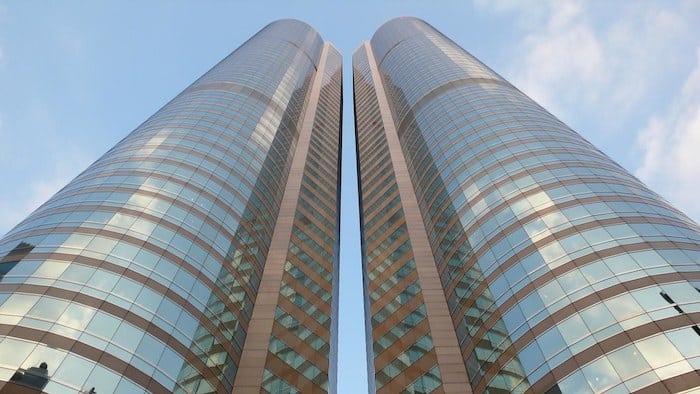
China Guangfa Bank found new quarters in Central’s One Exchange Square
Adding illness to injury, the coronavirus outbreak has brought vacancy in the world’s most expensive office location to its highest level in over five years, according to a report this week from JLL.
The property consultancy said that vacancy rates in Central jumped to 4 percent last month from 3.6 percent in December – the highest percentage of empty offices since 2014.
Traditionally the tightest market in Hong Kong, Central’s vacancy rate had stood at 2.3 percent in January last year, only five months before the protests started. By November, the district’s vacancy rate had climbed to 3.5 percent.
The figures from the firm’s January office leasing survey showed that the market in Central, which had already been weakened last year through waves of protests and tighter liquidity in mainland China, is being further undermined by the health crisis.
Emptying Central Offices Triggers Sliding Rents
The fresh evidence of a downturn comes after rents in the district that hosts the APAC headquarters of some of the world’s largest banks plunged more than six percent in the second half of 2019. The leasing slide prompted JLL to forecast at the end of last year that capital values and rents in Hong Kong’s traditional business district would fall by up to 20 percent this year – even before the COVID-19 scare.

JLL’s Alex Barnes says the COVID-19 scare has weakened demand for grade A office space
With Hong Kong’s slump now worsened by the outbreak of the coronavirus, JLL said that the emptying offices are fuelling a downward slide in Central rental values.
The district’s rents dropped 1.1 percent last month to HK$120 ($15.40) per square foot per month – the most severe drop of all Hong Kong’s core districts, according to JLL.
Finding Cheaper Rents in a Pricey District
As the district’s office sector stalls, JLL said new lettings in Central slid 49 percent last month compared to December, with activity mainly driven by companies making small expansions within the district.
In one of last month’s rare new contracts, China Guangfa Bank reportedly leased 13,000 square feet (1,208 square metres) at One Exchange Square for around HK$135 per square foot as the bank relocated to slightly larger quarters from 9 Queen’s Road.
With landlords finding it harder to secure tenants, the Guangdong commercial bank landed its new home rate rate 16 percent lower than the HK$160 per square foot per month that China Merchants Bank agreed to 18 months ago when it took over HNA’s former space in the same building.
Weakening Leasing Demand
As the coronavirus continues to menace the city, JLL says decision-makers are shying away from signing new leases, as rents keep heading downhill.
“Immediate demand has weakened off the back of the coronavirus, as a number of businesses put decision making on hold,” said JLL’s head of markets in Hong Kong, Alex Barnes. The leasing director noted, however, that some “pockets of activity exist, with the majority of demand in decentralised locations.”
Citywide, the average vacancy rate across Hong Kong rose from 6.0 percent to 6.1 percent in January, up from 4.4 percent for the same month in 2019.
Sliding Rents Hit Investment Volumes
Following a second half of 2019 that saw real estate investment in the Asian financial hub plunge to its lowest in a decade, the ongoing slide in rents is continuing to impinge on commercial property investment volumes in Hong Kong.
“Only a limited number of offices changed hands for relatively small lump sums,” said JLL’s head of research in Greater China and Hong Kong, Nelson Wong, adding that sales of both office and retail properties in January remained very slow.
According to data analytics firm Real Capital Analytics, deal volume in Hong Kong over the whole of 2019 stood at $15.2 billion – down 42 percent from the previous twelve months.
Leave a Reply